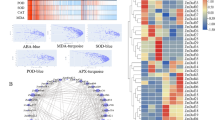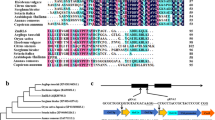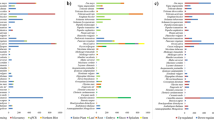Abstract
Drought severely affects the growth and development of maize, but there is a certain degree of compensation effect after rewatering. This study intends to elaborate the response mechanism of maize at the physiological and molecular level as well as excavating potential genes with strong drought resistance and recovery ability. Physiological indexes analysis demonstrated that stomata conductance, transpiration rate, photosynthesis rate, antioxidant enzymes, and proline levels in maize were significantly altered in response to drought for 60 and 96 h and rewatering for 3 days. At 60 h, 96 h, and R3d, we detected 3095, 1941, and 5966 differentially expressed genes (DEGs) and 221, 226, and 215 differentially expressed miRNAs. Weighted correlation network analysis (WGCNA) showed that DEGs responded to maize drought and rewatering through participating in photosynthesis, proline metabolism, ABA signaling, and oxidative stress. Joint analysis of DEGs, miRNA, and target genes showed that zma-miR529, miR5072, zma-miR167e, zma-miR167f, zma-miR167j, miR397, and miR6214 were involved to regulate SBPs, MYBs, ARFs, laccases, and antioxidant enzymes, respectively. Hundreds of differentially expressed DNA methylation-related 24-nt siRNA clusters overlap with DEGs, indicating that DNA methylation is involved in responses under drought stress. These results provide new insights into the molecular mechanisms of drought tolerance, and may identify new targets for breeding drought-tolerant maize lines.










Similar content being viewed by others
References
Azahar I, Ghosh S, Adhikari A, Adhikari S, Roy D, Shaw AK, Singh K, Hossain Z (2020) Comparative analysis of maize root sRNA transcriptome unveils the regulatory roles of miRNAs in submergence stress response mechanism. Environ Exp Bot 171:103924
Cao L, Zhang P, Lu X, Wang G, Wang Z, Zhang Q, Zhang X, Wei X, Mei F, Wei L, Wang T (2020) Systematic analysis of the maize OSCA genes revealing ZmOSCA family members involved in osmotic stress and ZmOSCA24 confers enhanced drought tolerance in transgenic arabidopsis. Int J Mol Sci 21:351
Chen X, Zhang Z, Liu D, Zhang K, Li A, Mao L (2010) SQUAMOSA promoter-binding protein-like transcription factors: star players for plant growth and development. J Integr Plant Biol 52:946–951
Claeys HID (2013) The agony of choice: how plants balance growth and survival under water-limiting conditions. Plant Physiol 162:1768–1779
Cramer GR, Urano K, Delrot S, Pezzotti M, Shinozaki K (2011) Effects of abiotic stress on plants: a systems biology perspective. BMC Plant Biol 11:163
Dhokane DK, Kushalappa S, McCartney AC (2016) Integrated metabolo-transcriptomics reveals fusarium head blight candidate resistance genes in wheat QTL-Fhb2. PLoS ONE 11:e0155851
Dilkes BP (2009) Analysis of gene expression and physiological responses in three Mexican maize landraces under drought stress and recovery irrigation. PLoS ONE 4:e7531
Dinakar C, Djilianov D, Bartels D (2012) Photosynthesis in desiccation tolerant plants: energy metabolism and antioxidative stress defense. Plant Sci 182:29–41
Ding Y, Tao Y, Zhu C (2013) Emerging roles of microRNAs in the mediation of drought stress response in plants. J Exp Bot 64:3077–3086
Dixon RA, Paiva NL (1995) Stress-induced phenylpropanoid metabolism. Plant Cell 7:1085–1097
Fang Y, Xiong L (2015) General mechanisms of drought response and their application in drought resistance improvement in plants. Cell Mol Life Sci 72:673–689
Fu J, Huang B (2001) Involvement of antioxidant and lipid peroxidation in the adaptation of two cool-season grasses to localized drought stress. Environ Exp Bot 45:105–114
Gao YJ, Dai W, Xiao Y, Zhang N, Li H, Lu Y, Wu M, Tao X, Deng D, Chen J (2015) A maize phytochrome-interacting factor 3 improves drought and salt stress tolerance in rice. Plant Mol Biol 87:413–428
Gent JI, Ellis NA, Guo L, Harkess AE, Yao Y, Zhang X, Dawe RK (2013) CHH islands: de novo DNA methylation in near-gene chromatin regulation in maize. Genome Res 23:628–637
Gong M (2016) Effects of calcium and calmodulin antagonists on chilling stress-induced proline accumulation in jatropha curcasl. J Plant Growth Regul 35:815–826
Guo LH, Chen SN, Wang DB, Gong M (2006) Changes in activity of glutathione reductase and it’s isozyme of maize seedlings during heat shock and heat stress. J Yunnan Univ
Hernandez IA, Alegre L, Munne-Bosch S (2006) Enhanced oxidation of flavan-3-ols and proanthocyanidin accumulation in water-stressed tea plants. Phytochemistry 67:1120–1126
Jia XM, Mendu V, Tang G (2010) An array platform for identification of stress-responsive microRNAs in plants. Methods Mol Biol 639:253–269
Kinoshita NW, Kasahara H, Liu H, Macpherson J, Machida C, Kamiya Y, Hannah Y, Chua MA (2012) IAA-Ala resistant3, an evolutionarily conserved target of miR167, mediates Arabidopsis root architecture changes during high osmotic stress. Plant Cell 24:3590–3602
Lea PJ (2002) Response of antioxidant enzymes to transfer from elevated carbon dioxide to air and ozone fumigation, in the leaves and roots of wild-type and a catalase-deficient mutant of barley. Phys Plant 104:280–292
Li Q, Gent JI, Zynda G, Song JW, Makarevitch I, Hirsch CD, Hirsch CN, Dawe RK, Madzima TF, McGinnis KM, Lisch D, Schmitz RJ, Vaughn MW, Springer NM (2015) RNA-directed DNA methylation enforces boundaries between heterochromatin and euchromatin in the maize genome. Proc Natl Acad Sci USA 112:14728–14733
Liu AC (2007) Effects of water stress on the physiological characteristics of bulbous flower leaves. J Northwest A&f Univ 35:77–80
Lotfi NVK, Amiri R, Kholdebarin B (2010) Drought-induced accumulation of sugars and proline in radicle and plumule of tolerant walnut varieties during germination phase. Acta Hort 39:289–296
Lu XM et al (2018) Identification and evaluation of drought resistance of maize inbred lines at seedling stage under PEG stress. J Henan Agr Sci 26:71–80
Martin RCA, Liu PP, Kristof JR, Coppersmith JL (2010) The microRNA156 and microRNA172 gene regulation cascades at post-germi native stages in Arabidopsis. Seed Sci Res 20:79–87
McCue KFH, Hanson AD (1992) Salt-inducible betaine aldehyde dehydrogenase from sugar beet: cDNA cloning and expression. Plant Mol Biol 18:1–11
Moxon S, Jing R, Szittya G, Schwach F, Rusholme Pilcher RL, Moulton V, Dalmay T (2008) Deep sequencing of tomato short RNAs identifies microRNAs targeting genes involved in fruit ripening. Genome Res 18:1602–1609
Oliveira MM (2004) Mechanism’s underlying plant resilience to water deficits: prospects for water-saving agriculture. J Exp Bot 55:2365–2384
Park MY, Kim JY, Kim SY (2011) Overexpression of AtMYB52 confers ABA hypersensitivity and drought tolerance. Mol Cells 31:447–454
Perrone I, Pagliarani C, Lovisolo C, Chitarra W, Roman F, Schubert A (2012) Recovery from water stress affects grape leaf petiole transcriptome. Planta 235:1383–1396
Qin YD (2011) Genome-wide characterization of new and drought stress responsive micro RNAs in populus euphoretic. J Exp Bot 62:3765–3779
Qu FF (2015) Physiological and biochemical mechanisms related to salt tolerance in plants. J Henan Sci Tech 6:141–143
Richards JHL (2014) Pre-dawn stomatal opening does not substantially enhance early-morning photosynthesis in Helianthus annuus. Plant Cell Environ 37:1364–1370
Sunkar R (2010) MicroRNAs with macro-effects on plant stress responses. Semin Semin Cell Dev Bio 21:805–811
Szabados LS (2010) Proline: a multifunctional amino acid. Trends Plant Sci 15:89–97
Tang JC (2017) MicroRNAs in crop improvement: fine-tuners for complex traits. Nat Plants 3:17077
Teare ID (1973) Rapid Determination of free proline for water-stress studies. Plant Soil 39:205–207
Tollenaar M, Lee EA (2002) Yield potential, yield stability and stress tolerance in maize. Field Crop Res 75:161–169
Vanková R, Dobrá J, Štorchová H (2012) Recovery from drought stress in tobacco. Plant Signal Behav 7:19–21
Wang Y (2015) Arabidopsis AtbHLH112 regulates the expression of genes involved in abiotic stress tolerance by binding to their E-box and GCG-box motifs. New Phytolt 207:692–709
Wang L, Liu H, Li D, Chen H (2011) Identification and characterization of maize microRNAs involved in the very early stage of seed germination. BMC Genomics 12:154
Wei LY, Zhang DF, Xiang F, Zhang ZX (2009) Differentially expressed mirnas potentially involved in the regulation of defense mechanism to drought stress in maize seedlings. Int J Plant Sci 170:979–989
Xu XJ, Ma Q, Ying X, Shen Q, Qian B, Song Y, Wang H (2014) Deep sequencing identifies tissue-specific microRNAs and their target genes involving in the biosynthesis of tanshinones in Salvia miltiorrhiza. PLoS ONE 9:e111679
Yang JHH, Yoon SJ, Lee EK (2006) Evidence of an auxin signal pathway, microRNA167-ARF8-GH3, and its response to exogenous auxin in cultured rice cells. Nucleic Acids Res 34:1892–1899
You CX (2015) Cloning and expression analysis of tomato LeLAC~ (miR397) gene. Semin Cell Dev Bio 21:805–811
Zemach A, Kim MY, Silva P, Rodrigues JA, Dotson B, Brooks MD, Zilberman D (2010) Local DNA hypomethylation activates genes in rice endosperm. Proc Natl Acad Sci U S A 107:18729–18734
Zheng J, Zeng E, Du Y, Ludens M, Fu J et al (2019) Temporal small RNA expression profiling under drought reveals a potential regulatory role of small nucleolar rnas in the drought responses of maize. Plant Genome 12:180058
Zhou L, Liu Y, Liu Z, Kong D, Duan M, Luo L (2010) Genome-wide identification and analysis of drought-responsive microRNAs in Oryza sativa. J Exp Bot 61:4157–4168
Acknowledgements
This research was funded by the National Key Research and Development Program of China, grant number 2017YFD0301106, and by China Postdoctoral Science Foundation, grant number 2020M682299, and by Henan maize industry technology system, grant number S2010-02-G10.
Author information
Authors and Affiliations
Contributions
L.C., X.L., L.W., and T.W. conceived and designed this research; L.C., P.Z., X.W., and X.L. performed the experiment; L.C., G.W., and Z.W. analyzed the data; L.C. and X.L. wrote the manuscript. All authors have read and agreed to the published version of the manuscript.
Corresponding authors
Ethics declarations
Conflict of interest
The authors have no conflicts of interest to declare.
Additional information
Communicated by Bing Yang.
Publisher's Note
Springer Nature remains neutral with regard to jurisdictional claims in published maps and institutional affiliations.
Supplementary Information
Below is the link to the electronic supplementary material.
Rights and permissions
About this article
Cite this article
Cao, L., Lu, X., Wang, G. et al. Transcriptional regulatory networks in response to drought stress and rewatering in maize (Zea mays L.). Mol Genet Genomics 296, 1203–1219 (2021). https://doi.org/10.1007/s00438-021-01820-y
Received:
Accepted:
Published:
Issue Date:
DOI: https://doi.org/10.1007/s00438-021-01820-y




